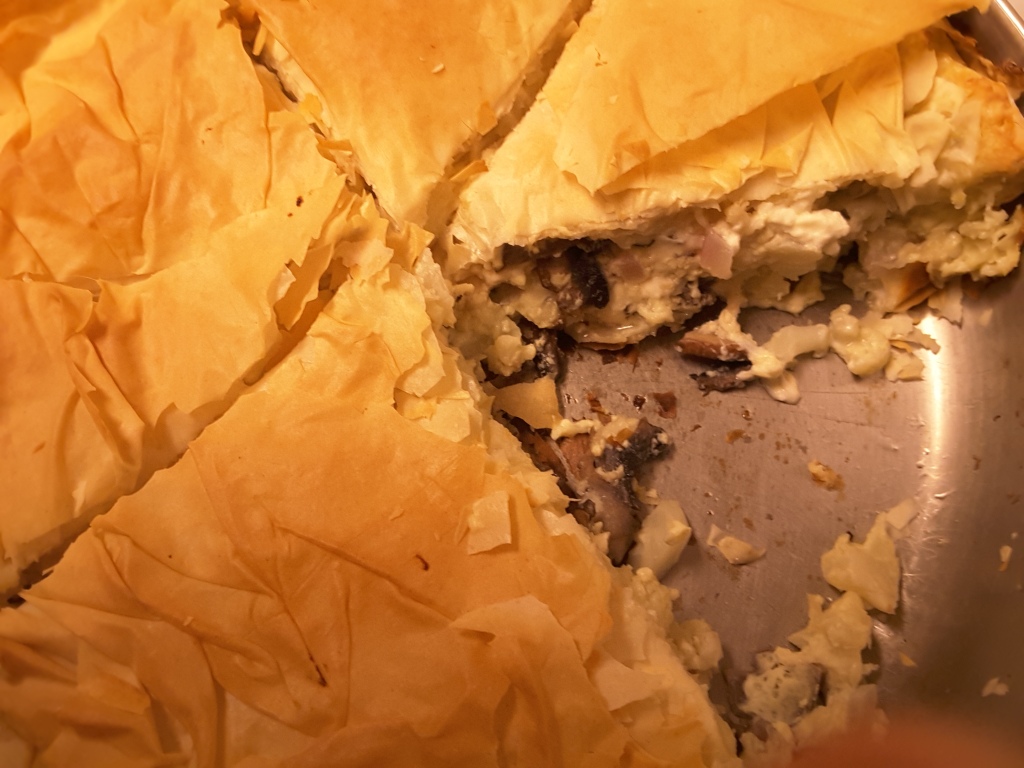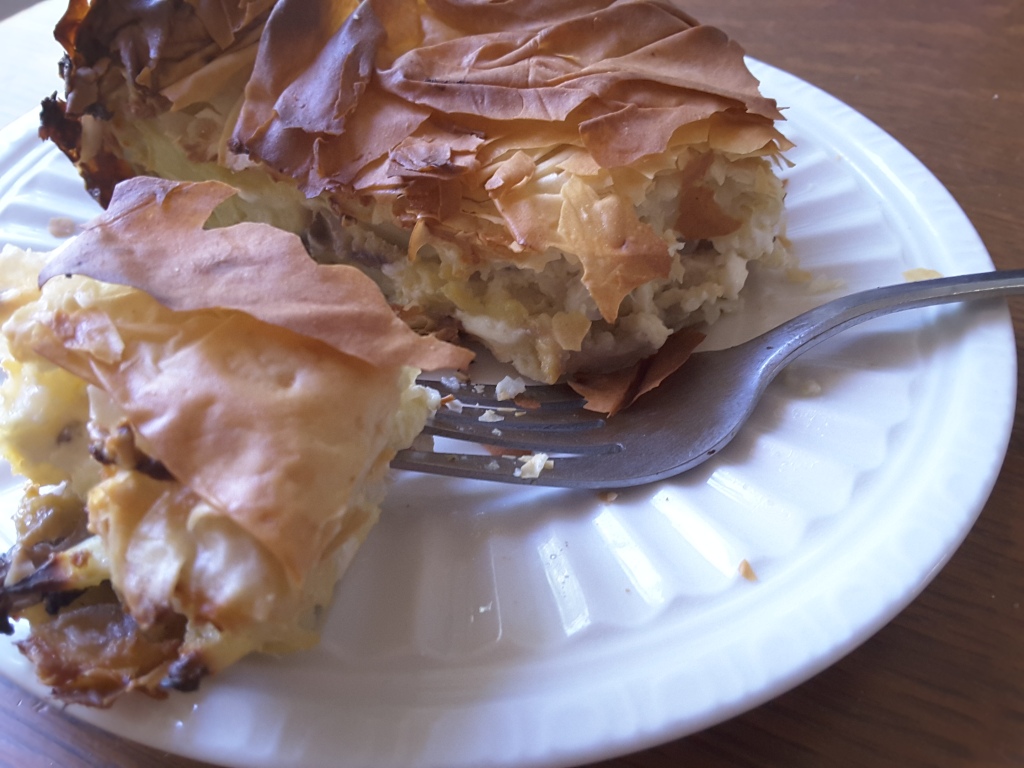(…plus a few more cheap cheese tricks)
I had bought a packet of fillo dough a while back, in the thought that by now I’d have a couple of fun party-food ideas to suggest. But this week I’ve been feeling like I’d rather make and serve something nonsweet, nonfussy and not heavy–an easy main dish for summer, lighter and more serious at the same time, and something that could last more than one meal and reheat quickly.
This vegetable-filled quiche is a flexible dairy main dish with a Mediterranean vibe thanks to its fillo crust. It looks a little fancier than an ordinary quiche, but it’s not actually difficult to put together, and it’s also not a heart attack on a plate.
The only trick, other than needing to bake it in a conventional oven rather than attempting the microwave (so don’t do it during the heat of the day), is to control the temperature and moisture so you get the egg and cheese filling to cook through without letting the fillo casing scorch or, possibly worse, get soggy. It stores well in the fridge for next-day dinners, and you can reheat and recrisp individual pieces quickly in the toaster oven, especially if you microwave first for half a minute on an open plate just to warm them through, then slide onto foil and toast a few minutes at a baking temperature slightly below full-stun toasting so you don’t scorch the tops.
I’ve made two versions of this by winging it, essentially, and it’s worked nicely both times. The first was an open-faced spinach and ricotta fillo tart that went well at a Chanukah party back in December, and it led me to this second riff, a cauliflower-mushroom-smoked cheese filling, this time sandwiched between top and bottom fillo layers.
Before I get into the recipe and tips for working with fillo specifically, let’s talk a little about flexibility by highlighting one of my hobbies, getting cheap with cheese:
Ricotta, if you have it, is a less-liquidy substitute for most of the usual milk in a quiche filling. It adds a little more protein and body without turning your quiche filling to lead. But given that ricotta prices have almost doubled this summer to something like $8-9 for 32 ounces, feel free to use other cheeses like queso fresco that aren’t feeling the inflation as much.
If they’re mostly in your quiche for bulk, protein and calcium, shred or whiz them in a food processor so they blend smoothly with the eggs and do add a bit of milk because they’re pressed cheeses with a lot less moisture than ricotta.
If your cheese is less for bulk or protein than for flavor and contrasting texture, as in the smoked mozzarella I threw in here, just slice or tear small pieces off instead.
You can’t always find the exact cheese in someone else’s recipe at a good price when you want it, and here it’s obviously not that critical. So work with what you’ve got–you can use any unsmoked mild, inexpensive cheese you like, like regular store brand block mozzarella, cheddar or colby, or white fresh-pressed rounds of queso fresco or panela, and just add a dash of smoked paprika to the quiche filling. Just do yourself a favor and don’t use something expensive.
And on that note, I’ve made a few more discoveries about stocking up on usually-expensive cheeses:
Keep a lookout for interesting cheeses on sale that are still unspoiled and in good enough shape to be genuine bargains in your price range–if you find something great at a fabulously low price, buy enough that you can use a little now and freeze the rest for later on. The last time decorator cheeses went on serious markdown at my local Ralph’s/Kroger, a month or so ago, I picked up five half-pound balls of fresh smoked mozzarella for a dollar apiece (regular price, $5.99 each, so well worth snagging that many) and then I stuck most of them in the freezer for later use. They’re still going and still great.
You can actually freeze and then revive a surprising range of cheeses if you thaw them gently. Thaw any frozen cheese slowly, preferably overnight in the fridge or several hours on a countertop, or perhaps (very) well-wrapped in a bowl of lukewarm water, and then in the fridge, to try and restore texture. This works for mozzarella and fresh mozzarella, feta, and panela, though not perfectly for queso fresco, which has more water and more crumbliness to begin with, and ends up a bit grainy after freezing. It may be that the more rubbery pressed cheeses like mozzarella or panela bounce back a little better.
Waxier hard-pressed cheeses–Asiago, swiss and cheddar-type cheeses can just go in the fridge overnight. Bleu may end up a bit drier and more crumbly than you expect, I haven’t exactly tested it thawed, so I’m not sure. But I have crumbled it straight from the frozen block for a yogurt-based dip and it tasted fine. I also have a wedge of sale brie in the freezer, and eventually I will bring it out of hiding to see if the texture can be salvaged after thawing or not–if it’s not great but still semi-ok, I’ll wrap it in fillo and bake it (when in doubt, melt it and hope for the best)–and report back.
If you do have bargain bleu, frozen or not, a little of that crumbled into the quiche filling would be great instead of smoked cheese, as long as you’re willing to smell it cooking, because the smell can definitely travel throughout your house. On that theme–Limburger only in revenge, at someone else’s house as a heat-and-serve Trojan Quiche where you’ll find mysteriously that you simply must dash just after your victim has put it in the oven…
—-Ahem! Okay, back to quiche…
My other basic tips for winging it with the fillo-crust recipe:
First, pre-nuke your veg on an open plate for a few minutes and either drain it well before putting it into the bottom crust or use a bit less milk in the filling to compensate for the added moisture.
Second, don’t add a lot of milk to the egg and cheese mixture, and make sure to scald the milk you do add for a minute or so in the microwave before stirring it in. The hot milk gets the custard started. You don’t need cream to make it work–in fact, with as much veg and cheese as this contains, I definitely wouldn’t bother.
Line your baking pan with parchment paper if you have it, or tinfoil, or just oil the pan gently before folding in the fillo sheets for the bottom crust. Don’t worry about laying each sheet in perfectly, do it reasonably quick and dirty and as long as the fillo’s covering the bottom of the pan and up the sides more or less evenly, in a couple of layers and about the right shape, you’re good.
Finally, the balance between soggy and scorched. Before I actually tried it, I was going to say don’t put any fillo sheets on top, so the filling bakes through in direct heat and sets up well and doesn’t accidentally sog through everything. But in fact the top fillo sheets do fine as long as you score through them with a sharp knife before baking to let steam out. Turn down the heat a little after the quiche has cooked partway and is barely starting to brown, so the top layers can go another 20 minutes or so without scorching while the filling cooks through. Then the top puffs up a bit and lends a crunchy suntanned elegance to the basic quiche.

Fillo-Wrapped Cauliflower Mushroom Quiche
Vegetables
- 2-3 cups (half to one head) of cauliflower, sliced a little smaller than bite-size, about 1/4-1/2 inch thick
- 1/4-1/2 medium onion, chopped
- enough large crimini or other basic mushrooms for a generous handful or two of slices
Filling and cheese
- 4 large eggs
- 8-10 oz mug skim milk
- 1-2 T flour (or cooked rice or potato starch or breadcrumbs or matzah meal)
- 10-12 oz ricotta and 1-2 oz crumbled feta or bleu OR
- 4-6 oz smoked cheese (mozzarella, provolone, cheddar or gouda) sliced or in small chunks OR unsmoked mild cheese–mozzarella, cheddar, queso fresco, whatever you’ve got, grated or chopped, plus smoked paprika as below
Flavorings
- large clove of garlic, minced, mashed or grated
- good pinch of dry thyme or 2-3 sprigs worth of fresh leaves
- 2-3 sage leaves, minced or crumbled, or a tiny pinch or grating of nutmeg
- Optional:
- large pinch or so of smoked paprika if your cheese is not smoked
- pinch of hot pepper flakes or fresh-ground black pepper
Crust
- 8-10 sheets fillo dough, from a roll that you’ve thawed overnight in the fridge or for at least 4-5 hours at room temperature.
- olive or salad oil, about 3-4 T or just as needed
Preheat the oven to 400 F (200 C). Microwave the chopped vegetables together on an open plate or in a lidded container for 2-3 minutes on HIGH to parcook. Microwave a mugful of milk for 2 minutes to scald it. Crack the eggs into a mixing bowl and beat well with the flour, rice, breadcrumbs, whatever starch you’re using. Add the flavorings. Slowly drizzle in the scalded milk as you whisk vigorously to avoid curdling the eggs. Stir in the cheeses and vegetables.
Prepare the fillo crust: oil a deep dish pie plate, casserole or lasagna pan or or use parchment paper to line it. On a clean surface, unroll the fillo dough and gently separate the top sheet. Lay it in the pan either opened out fully with a few drops of olive oil drizzled on or drizzled and then folded in half like a book. Drizzle or dab a little more olive oil over it with your fingers and lay on the next sheet in an overlapping pattern. Continue so that eventually 4 or 5 sheets, single or doubled, as you prefer, line the bottom and sides of the pan completely. For a round casserole or pie plate, overlap the sheets in a pinwheel. For a square or rectangular pan, you can stack open sheets on top of each other the traditional way or overlap book-folded ones down the length of the pan, so long as the bottom is fully covered by multiple layers and the edges of the fillo come up the sides and drape a little over the edge.
Pour the filling into the pan. Clean and dry your hands if necessary before layering on the top sheets of fillo to cover the quiche. Tuck in all the corners, drizzle and smooth on a little more olive oil so that the top sheet and edges are lightly coated. With a small sharp paring knife, score just through the top fillo layers into serving portions, using small controlled sawing motions and gently holding the fillo layers in place with your other hand as you go. For the lasagna pan, you’ll probably want squares; for a circular pie plate or casserole, score the quiche into wedges.
Bake the casserole for 15-20 minutes, turn the oven temperature down to 375 F (~180 C) and bake for another 20-25 minutes. Test with a clean sharp knife, poking it gently through one of the scoring cuts you made, to see if the custard is cooked through to the bottom yet. If not, give it another 10-15 minutes. If at any point the top layer of fillo looks like it’s getting browner than you want, loosely cover it with a piece of foil to shield it while the quiche cooks.
Bon appétit, mangia bene, בטאבון, eat nice, and stay cool…
Filed under: appetizers, baking, cooking, Dairy, Vegetabalia | Tagged: food, recipes, vegetarian |




